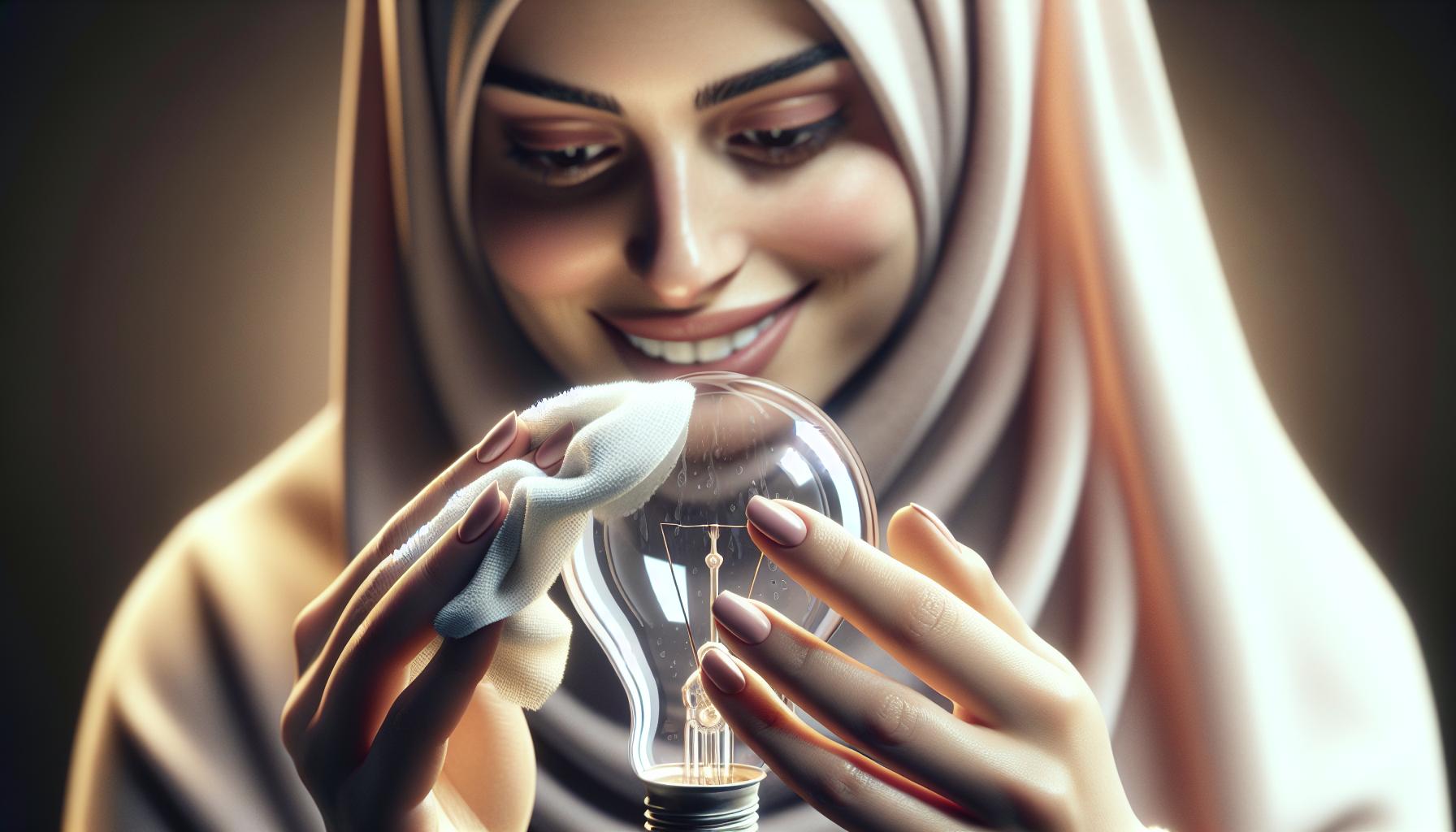Ever stumbled upon a dusty bulb and wondered if giving it a good wash might brighten things up? You’re not alone! Clean lighting can indeed transform a room, but when it comes to light bulbs, the do’s and don’ts aren’t always clear.

Before you roll up your sleeves and grab the nearest sponge, let’s shed some light on the best practices for keeping your bulbs shining bright without causing any damage. After all, safety’s just as important as sparkle when you’re dealing with electricity.
Can You Wash Light Bulbs?
Sure, you can wash light bulbs, but it’s not as straightforward as dunking them in soapy water. The delicate nature of light bulbs means you’ve gotta handle them with care. Before you start, it’s important to note that water and electricity are a dangerous duo. So first things first, make sure the light bulb is completely powered off and cool to the touch. Unplug the lamp or switch off the circuit if you’re dealing with fixed lighting.
Let’s talk about what you’ll need:
- Soft cloth
- Mild detergent
- Water
Take a damp cloth, add a tiny drop of mild detergent, and carefully wipe the bulb’s surface. Don’t apply too much pressure; you don’t wanna risk shattering the glass. If your bulb’s a bit more soiled, holding it by the base while cleaning can give you a safer grip. Just remember to avoid getting any moisture near the metal socket or the base of the bulb—water can cause corrosion or, worse, a short circuit next time you flip the switch.
For those of you with LED bulbs, you’re in luck! These modern marvels are a bit more forgiving. A quick swipe with a damp cloth usually does the trick since they don’t heat up like traditional bulbs. However, make sure you’re not using water on any part of the bulb that houses electronic components, like the base of some LED models.
In terms of drying, play it safe and air dry thoroughly. Patience is key. You’ll want to stay away from abrasive materials, like paper towels, which can leave scratches or residue. Instead, use that soft cloth again or let the bulb sit until it’s completely dry.
If you follow these tips, washing your light bulbs can be a breeze. A clean bulb not only shines brighter but also ensures efficiency and longevity—keeping your home illuminated exactly the way you love.
Understanding Light Bulb Materials

Your home’s ambiance significantly hinges on the performance and longevity of your light bulbs. To maintain that cozy glow, knowing what materials make up your light bulbs is key, especially when you’re considering how to keep them clean.
Incandescent bulbs, for many years the standard, have a delicate tungsten filament enclosed in a glass globe. The glass can withstand a wipe-down with a mildly moistened cloth, but bear in mind—these bulbs can be quite frail. In contrast, halogen bulbs, a type of incandescent, have a stronger glass that can handle a bit more pressure. However, always handle them with care to prevent premature breakage.
When it comes to LED bulbs, they’re the sturdiest in your lighting arsenal. Enclosed in a shatter-resistant plastic or glass, they are more forgiving when it comes to maintenance. LED technology not only outlives traditional incandescent bulbs but also holds up better against the occasional jostle during cleaning.
For compact fluorescent lights (CFLs), caution is the name of the game. These bulbs are made of a twisted glass tube, and they include a small amount of mercury—a toxic substance. Remember to never immerse CFLs in water or use a wet cloth. Instead, opt for a dry, soft-bristled brush to dust off these sensitive bulbs.
Here’s a quick rundown of bulb materials:
- Incandescent: Thin glass, fragile
- Halogen: Thick glass, handle with care
- LED: Plastic or sturdy glass, resilient
- CFL: Twisted glass, contains mercury, dry dust only
Materials used in the bulb’s construction influence how heat resistant and durable it is. For instance, the metal base common to most bulbs conducts heat and electricity. Therefore, always keep that part dry to avoid corrosion or electrical issues.
« What Light Bulbs Help with Depression? Discover the Best Options for Mood-Enhancing Lighting
Why Is Buying Light Bulbs So Difficult? Decode the Science to Light Up Your Home »
While the socket of the bulb never gets the glory, it’s made of solid metal—usually brass or aluminum—and requires a gentle touch. Keep harsh chemicals away from these areas, as they can accelerate the wear and tarnish that naturally occurs over time.
Arming yourself with knowledge on the various materials that make up those glowing orbs in your home empowers you to care for them more effectively, ensuring a brighter, cleaner light every time you flip the switch.
Safety First: Unplug and Cool Down

Before you dive into cleaning your light bulbs, safety should be your top priority. Unplugging your light fixtures before starting the cleaning process is not just a suggestion—it’s a necessity. Working with anything electrical carries a risk, and water is a known conductor of electricity. So you definitely don’t want to mix the two. Even if you’re using a dry cloth or brush, it’s better to err on the side of caution and remove any possibility of electric shock.
Assuming you’ve unplugged your lamp or turned off the light switch, there’s another safety tip that’s often overlooked. Light bulbs, especially incandescent and halogen types, can get quite hot. Allow your bulbs to cool down completely before you attempt to touch them. This might mean waiting a few minutes. Patience is key here to avoid the discomfort of a surprise burn or the potential shattering of hot glass.
Here’s a quick guideline to keep in mind:
- Incandescent bulbs: May take about 10-15 minutes to cool down.
- Halogen bulbs: Can get hotter than incandescents, so give them 15-20 minutes.
- CFLs: Don’t get as hot, but still wait about 5-10 minutes.
- LED bulbs: Since they’re the coolest, a couple of minutes will suffice.
Once your bulbs are cool to the touch, you’ll be ready to tackle the cleaning with peace of mind knowing you’ve minimized your risk. Remember, you’re dealing with a variety of materials and components when it comes to light bulbs. Therefore, being aware of the different cooling times and handling each type with care is crucial for your safety and the bulb’s longevity. Whether you’re a lighting aficionado or a home DIY enthusiast, always put your safety first to ensure your projects are both fun and accident-free.
Wet or Dry: Choosing the Right Cleaning Method

When facing the task of cleaning light bulbs, you’re probably wondering if it’s better to go for a wet wash or stick to a dry dusting. The truth is, the best approach varies with the type of bulb as well as the degree of dirtiness.
For general dust and debris, a dry wipe is often sufficient and is the safest choice. Use a soft cloth or a duster to gently remove dust from the bulb’s surface. If you’re a fan of DIY, you might even craft your own customized duster from microfiber material, which is ideal for this purpose due to its electrostatic properties that attract dust.
On the other hand, sometimes you can’t avoid a little grime buildup, particularly on bulbs in areas exposed to cooking vapors or heavy traffic. In such cases, a damp cloth can do wonders. Before you proceed with any wet cleaning methods, ensure you’ve unplugged the fixture and the bulb has completely cooled down – this is crucial to prevent electric shock and to avoid the risk of the bulb breaking due to a sudden change in temperature.
Approved Cleaning Agents for Different Bulb Types:
- Incandescent and Halogen Bulbs: A touch of water on a soft cloth is fine, but avoid any harsh chemicals.
- CFLs: Stick to dry cleaning because moisture can damage the electronic components.
- LEDs: Gentle wet wiping is acceptable; however, avoid getting any water in the base where the electronics reside.
Remember, never submerge the light bulbs in water. The internal components and wiring are not designed to be water-resistant, and this can permanently damage the bulb. For stubborn spots, a bit of rubbing alcohol on a cloth can be useful, especially for glass bulbs, but use it sparingly.
If you’re deep into home DIY projects or are passionate about lighting, you know that keeping your bulbs clean is not just about brightness but also about efficiency. Clean bulbs tend to run a bit cooler and can have a longer lifespan than those caked with dust and dirt. Good maintenance is key to ensuring optimal performance and extending the life of your bulbs. So choose your cleaning method wisely, and let that light shine through just as brightly as the day you screwed it in.
Cleaning Incandescent Bulbs

When you’re dealing with incandescent bulbs, the first rule is always to turn off the power and let the bulb cool completely. Incandescent bulbs get quite hot during operation, and they’re more fragile when warm. Once the bulb is cool to the touch, you can begin the cleaning process.
A dry, soft cloth is usually all you need for routine dusting. A quick wipe removes loose debris, keeping the bulb’s surface clear. If you notice fingerprints or other marks on the glass, dampen a part of your cloth with a bit of water or rubbing alcohol, and gently rub the affected area. Be cautious though—rubbing too hard can damage the filament inside, especially if the bulb’s been on recently and hasn’t had sufficient time to cool down.
If your incandescent bulb has grime that won’t come off with just a damp cloth, diluted dish soap can be an effective but gentle cleaner. Use the following steps:
- Mix a few drops of dish soap with water.
- Dip your cloth into the soapy mixture and wring it out well—you want it damp, not dripping.
- Wipe the bulb gently, avoiding any contact with the metal base.
Remember, water and electricity are a perilous combination. Never clean the bulb’s base or any part of the fixture with a wet cloth. Instead, use a dry brush or cloth to clean these areas, ensuring no moisture risks getting into the electrical components.
When you’re done, dry the bulb with a fresh, dry cloth or allow it to air dry completely before turning the light back on. Regular cleaning helps to maintain the optimal brightness and efficiency of your incandescent bulbs. Plus, keeping bulbs clean can extend their lifespan, saving you money and the hassle of frequent replacements. As you care for your bulbs, remember you’re not just tidying up—you’re enhancing the beautiful glow that makes your home feel so warm and inviting.
Cleaning LED Bulbs
Switching gears to LED bulbs, you’ll find they behave quite differently from their incandescent cousins. Due to their energy efficiency and lower heat output, LEDs don’t attract as much dust or insects, making them easier to clean.
First things first, safety is paramount. Always turn off the power to your LED bulb and ensure it’s cool to the touch before you start. Unlike incandescent bulbs, LEDs contain small electronic components, which means you’ve got to treat them with a bit more care.
For regular dusting, a soft, dry cloth is often all you need to keep your LEDs shining bright. Run the cloth gently around the bulb’s surface and its housing—if your bulbs are dimmable, you’ll want to avoid leaving behind any residue that could interfere with the connection.
Sticky spots or fingerprints? No problem. Take a slightly damp cloth and add a drop of dish soap if needed. Wipe the affected area carefully, and remember, like with incandescents, you don’t want to get the base of the bulb wet. A Q-tip can be your best friend for reaching those tight spots around the LED’s base or within its housing.
Have you got LED bulbs in hard-to-reach places? Consider using a telescopic duster. These handy tools extend your reach without the need for a ladder and are soft enough not to harm the bulb.
Remember that an LED bulb’s lifespan is a marathon, not a sprint. By taking the time to clean your LEDs carefully, you’re not just improving their performance; you’re contributing to their already impressive longevity. With proper maintenance, some LEDs can last over 25,000 hours—that’s a lot of cozy evenings and bright mornings in your future.
Keeping your LEDs clean also ensures you get the most lumens per watt. Dirt and dust can dim your lighting over time, requiring more energy to achieve the same brightness. Simple upkeep will keep your energy bills down and your home ambiance just right.
Cleaning Compact Fluorescent Bulbs
When you’re dealing with compact fluorescent bulbs (CFLs), you’ve got to handle them a bit differently than LEDs. That twisty design might look cool, but it can collect more dust and it’s a bit more fragile. First, ensure the power’s off and the bulb is not just cool but cold to the touch. You really don’t want to crack the glass.
For the best clean without damage, softly brush off the dust using a clean, soft-bristle paintbrush or a feather duster. You’ll find these tools gentle enough not to break the bulb but effective in whisking away the dust.
If you’ve got some grime that’s a bit stubborn, you can use the same approach as with LED bulbs – a slight dampness. Dampen a cloth with a bit of water mixed with gentle dish soap and carefully wipe the bulb. Be extra cautious to avoid getting the base or any electrical components wet. If the base does get a smidge of moisture, wipe it dry immediately.
Aiming to get into the little nooks and crannies? A Q-tip or soft toothbrush dipped in soapy water will do the trick. Just like with your LED bulbs, remember that less is more when it comes to moisture.
While you’re up close and personal with your CFLs, take a moment to inspect them. If you spot any discoloration or blackening at the base, it might signal the end is near. These bulbs contain a small amount of mercury so it’s crucial to follow proper disposal guidelines when they’ve served their time. Most hardware stores or recycling centers accept them, keeping harmful substances out of landfills.
Cleaning Halogen Bulbs
Unlike CFLs, halogen bulbs require a different approach due to their design and the high temperatures they can reach. It’s essential to handle these bulbs with care, not only for cleaning but also to extend their lifespan. Always ensure the power is turned off and the bulb is completely cool to the touch before you begin.
When you’re ready to clean, avoid touching halogen bulbs with your bare hands. Oils from your skin can create hot spots on the bulb’s surface, shortening its life. Instead, wear gloves or use a soft cloth to handle the bulb. To remove dust, gently wipe the bulb with a dry microfiber cloth. It’s super effective at trapping dirt without scratching the sensitive glass.
For tougher marks that won’t dust away, dampen your cloth with a bit of alcohol or a specialized cleaning solution designed for electronics. Wipe the bulb carefully without saturating it. Remember, don’t let any moisture reach the bulb’s base or wiring. Ensure that the bulb is entirely dry before restoring power, as any residue could potentially damage the bulb when it heats up during use.
In addition to the bulb itself, periodically check the fixture and surrounding area. Dust and debris can accumulate on lamp shades or reflectors, which can affect the light quality and efficiency. A duster or similar tool will be your best friend to keep these areas clean.
Don’t forget that halogen bulbs, while durable, do have a lifespan. Keep an eye out for dimming or flickering, which can signal that it’s time for a replacement. Plus, always follow the manufacturer’s instructions for specific cleaning requirements to keep your halogen bulbs shining bright and performing at their best.
While halogen bulbs are robust, they’re also more compact and emit significantly more heat than other types. Because of this, even after you’ve turned your lights off, give them plenty of time to cool down. Patience is paramount when you’re looking to maintain your lighting efficiently — it’s worth the wait to ensure your safety and the bulb’s longevity.
Special Considerations for Outdoor Bulbs
When you’re dealing with outdoor light bulbs, your approach needs to adjust to the elements. Outdoor bulbs face rain, wind, and even the occasional critter encounter, so the stakes are higher when it comes to cleaning and maintenance.
Firstly, never forget that safety is paramount. Make sure your outdoor fixtures are switched off and bulbs are cool to the touch before you even think about starting to clean them. You’re not just dealing with the bulbs here but also with exposure to the elements, which can compound risks.
Outdoor bulbs tend to collect more dirt and debris than their indoor counterparts. Here’s what you need to know:
- Use Soft Brushes: A soft brush can be your best ally here, gently sweeping away cobwebs and loose dirt without risking damage to the bulb or fixture.
- Avoid Harsh Chemicals: Steer clear of harsh cleaning agents that might not only damage the bulb but can also be hazardous if they drip or run off into your garden or home’s exterior.
- Check Seals and Covers: Outdoor bulbs often have protective seals or covers. Make sure they’re intact and clean, as they’re your first defense against the weather.
LED Bulbs: If you have LED bulbs outside, they’ll thank you for a gentle wipe-down with a damp cloth. Just ensure it’s not too wet – LED bulbs are resistant to many things, but a soaking isn’t on the list.
In areas prone to bugs and insects, you might notice that little flying visitors are attracted to the warmth of your bulbs. After cleaning, consider using a bug spray around the fixture – but not directly on the bulb – to keep critters at bay.
Remember that outdoor bulbs also need to be checked for wear and tear more frequently. Corrosion or damage to the bulb or fixture not only affects performance but could also lead to safety issues. Inspect the wiring and replace any bulbs that show signs of damage. With outdoor lighting, it’s all about staying vigilant and keeping those lights shining bright.
Conclusion
Now that you’ve got the scoop on keeping your light bulbs sparkling clean, remember that a little maintenance goes a long way. Whether it’s the bulbs inside your home or the ones braving the elements outdoors, a gentle touch and the right approach can keep them shining bright. Stay safe, let them cool, and never underestimate the power of a soft cloth. Keep an eye out for any damage, and you’ll not only brighten up your space but also extend the life of your bulbs. Happy cleaning!
Frequently Asked Questions
How should outdoor light bulbs be cleaned?
Before cleaning outdoor light bulbs, turn off the power and allow the bulbs to cool. Use a soft brush to sweep away cobwebs and loose dirt gently. Avoid harsh cleaning agents and soakings. For LED bulbs, a damp cloth can be used for wiping. Check for and address any damage to protective seals or covers.
Is it safe to clean light bulbs when they are turned on?
No, it’s important to turn off the power and let the bulbs cool down before cleaning to ensure safety.
Can I use harsh cleaning agents on outdoor light bulbs?
Harsh cleaning agents should be avoided as they may damage the bulb’s surface. Stick to gentle cleaning methods.
What should I do if I find damage on the outdoor light bulb?
If you notice any signs of damage such as cracks or breaks, address them promptly to maintain safety and bulb efficiency.
How can I prevent bugs from gathering around my outdoor light bulbs?
You can use bug spray around the light fixture to deter insects from congregating around your outdoor light bulbs.




